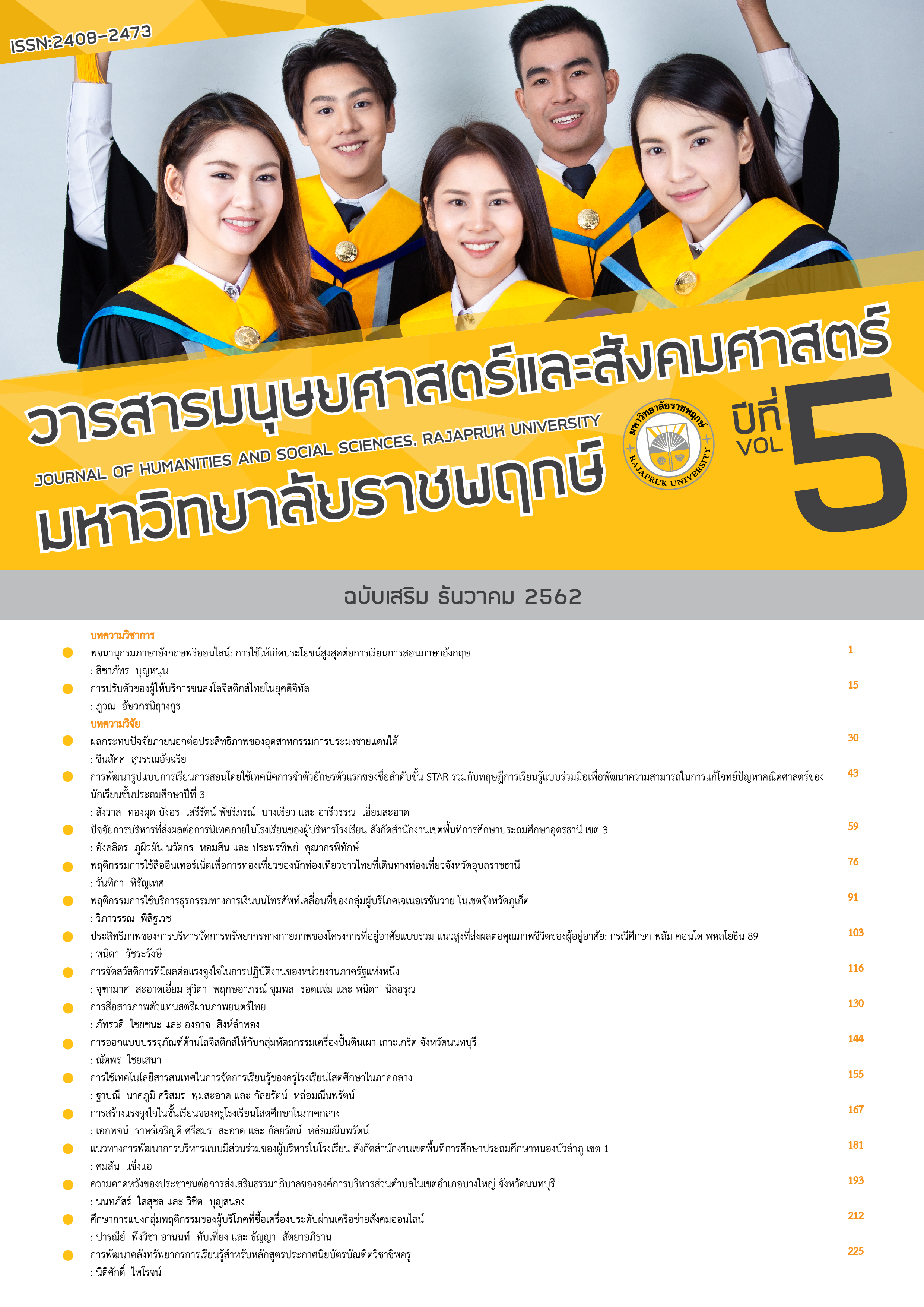The Development of Instructional Model Using the First Character Recognition Technique of The Sequence of STAR together with Cooperative Theory to Develop Mathematical Word Problem-Solving Skills for Grade 3 Students
Main Article Content
Abstract
The development of instructional model using the first character recognition technique of the sequence of STAR together with cooperative theory to develop mathematical word problem-solving skills for grade 3 students, and 2) to develop mathematical word problem-solving skills for grade 3 students before and after learning using the first character recognition technique of the sequence of STAR together with cooperative theory. The sample group selected form 36 in grade 3 students of Watsrinuanthammawimon School. Research tools consist of learning management plan and a test to measure mathematical word problem-solving skills. Statistics used in data analysis were mean, standard deviation and t-test. The research found that development of instructional model with cooperative theory to develop mathematical word problem-solving skills for grade 3 students was composed of the following components: 1) Include theories, principles, concepts of model. 2) The objectives of model 3) Teaching process 4) The results that of the study will be given based on the model of learning. The develop mathematical word problem-solving skills for grade 3 students before and after learning showed that mathematical word problem-solving skills for grade 3 students after studying higher than before learning at the statistical significance of .05
Article Details
References
เกวลิน ปลั่งกลาง. (2559). การใช้โปรแกรม GSP ประกอบการจัดกิจกรรมการเรียนรู้ตามกลวิธีSTAR เพื่อพัฒนาผลสัมฤทธิ์ทางการเรียน เรื่อง การบวก ลบ คูณ หาร ระคน สำหรับนักเรียนชั้นประถมศึกษาปีที่ 3. วิทยานิพนธ์วิทยาศาสตรมหาบัณฑิต สาขาคณิตศาสตร์และเทคโนโลยีการสอน มหาวิทยาลัยราชภัฏนครราชสีมา.
ชูขวัญ สารดิษฐ์. (2557). การเปรียบเทียบผลสัมฤทธิ์ทางการเรียน และเจตคติต่อการเรียนคณิตศาสตร์เรื่องการคูณ ของนักเรียนชั้น ประถมศึกษาปีที่ 4 โดยใช้วิธีสอนตามรูปแบบการเรียนรู้แบบร่วมมือด้วยกิจกรรม TGT กับกิจกรรม TAI. วิทยานิพนธ์ครุศาสตร
มหาบัณฑิต สาขาวิชาหลักสูตรและการสอน มหาวิทยาลัยราชภัฏเทพสตรี.
มาเรียม นิลพันธุ์. (2555). วิธีวิจัยทางการศึกษา. พิมพ์ครั้งที่ 7. นครปฐม: โรงพิมพ์มหาวิทยาลัยศิลปากร นครปฐม.
สถาบันส่งเสริมการสอนวิทยาศาสตร์และเทคโนโลยี. (2560). ตัวชี้วัดและสาระการเรียนรู้แกนกลาง กลุ่มสาระการเรียนรู้คณิตศาสตร์ (ฉบับปรับปรุง พ.ศ.2560) ตามหลักสูตรแกนกลางการศึกษาขั้นพื้นฐาน พุทธศักราช 2551. กรุงเทพฯ: คุรุสภาลาดพร้าว.
สำนักทดสอบทางการศึกษาแห่งชาติ. (2561). ผลการประเมินการทดสอบความสามารถพื้นฐานของผู้เรียนระดับชาติ (NT). ค้นเมื่อวันที่ 14 พฤษภาคม 2561 จาก, http://180.180.244.45/ExamWeb/ MainSch/MainSch.aspx.
Ajose, S.A., and Joyner, V. G. (2004). Cooperative Learning: The Rebirth of an Effective Teaching Strategy. Education Horizons. 198.
Butler, F. M., S. P. Miller, K.Crehan, B. Babbitt, and T. Pierce. (2003). Fraction instruction for students with mathematics disabilities: Comparing two teaching sequences. Learning Disabilities Research & Practice, 18 (2): 99-111.
Clarkson, S. P. (1979). A Study of the Relationship among Translation and Problem Solving Abilities. Dissertation Abstracts International, 39 January 1979: 4101-A.
Maccini, P., and Hughes, C. A. (2000). Effects of a problem solving strategy on the introductory algebra performance of secondary students with learning disabilities. Learning disabilities research & practice. 15(1): 10 - 21.
National Institute of Educational Testing Service. (2018). The Results of the Assessment of the Basic Ability of National Test (NT). Retrieved on 14th May, 2018, from http://180.180.244.45/ExamWeb/ MainSch/MainSch.aspx. (in Thai)
Nillapun, M. (2012). Research Methodology in Education. 7th ed. NakhonPathom: University Press Silpakorn Nakhon Pathom. (in Thai)
Plangklang, K. (2016). Using the GPS Program to Supplement Learning Activities by STAR Strategy to Develop Mathematics Achievement on Mixed Operations with Addition, Subtraction, Multiplication and Division for Prathomsuksa 3 Students. Master of Education (Science in Technology in Mathematics and Technology for Teaching) Thesis Nakhon Ratchasima Rajabhat University. (in Thai)
Saradit, S. (2014). A Comparison of the Learning Achievement and Attitude toward Learning of a Mathematic subject Multiplication of the Prathomsuksa 4 Students using to teach the form of learning Cooperative form the Activities TGT with the Activities TAI. Master of Education (Curriculum and Instruction) Thesis. Chanthaburi: Thepsatri Rajabhat University. (in Thai)
The Institute for the Promotion of Teaching Science and Technology. (2017). Indicators and Learning Content Core of Mathematics (2017 Edition) according to the Curriculum Core for Basic Education, 2008. Bangkok: Teachers’ Council of Thailand, Ladprao. (in Thai)
Vaughan, Winston. (2002). Effects of Cooperative Learning on Achievement and Attitude Among Students of color. Journal of Educational Research, (359-364).
Weeraratananusorn, K. (2017). The Study of Students’Learning Achievement for Business Finance Course in Cooperative Learning with Student Teams Achievement Division (STAD). Journal of Humanities and Social Sciences Rajapruk University, 3(2): 31. Retrieved on 24th January, 2018, from https/www.tci-thaijo.org/index.php/rpu/article/view/112593/87706 (in Thai)


